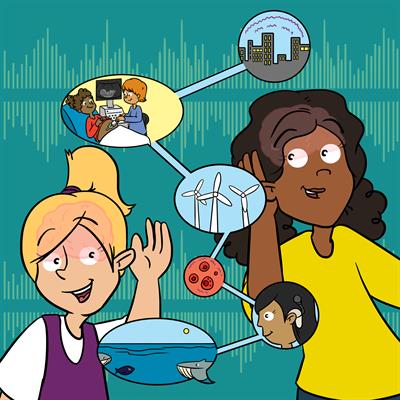
A world of sound
Collection Editors
Christian Sumner, Francesco Aletta, Gianluca Memoli, Naomi CuratiViews
722,606 viewsParticipating Sections
Submission Deadline
Closed
Articles

Human Health
23/06/2023
Auraldiversity: Do You Hear Differently?
Authors
John L. Drever, Vinita Bharat
Astronomy and Physics
22/06/2023
How Long Is a Note? Simple Experiments to...
Authors
Naomi Curati, Caryl Hart, Gianluca Memoli
Neuroscience and Psychology
18/05/2023
What Happens When We Hear?
Authors
Christian J. Sumner, Michael A. Akeroyd, Joseph Sollini...
Astronomy and Physics
14/03/2023
The Light and Sound Quiz Show
Authors
Gianluca Memoli
Biodiversity
30/11/2022
Snapping Shrimp and Their Crustaceous Cacophony
Authors
Cian Jones, Chiara Benvenuto, Paul Kendrick
Human Health
24/11/2022
The Sounds Around Us in Cities and Buildings
Authors
Francesco Aletta, Simone Torresin
Earth Sciences
20/10/2022
Ocean Noise: The Human Footprint on Underwater...
Authors
Ellen L. White, Nikhil Mistry, Paul R. White
Neuroscience and Psychology
22/08/2022
How What You See Can Influence What You Hear
Authors
Paula C. Stacey, Christian J. Sumner
Astronomy and Physics
17/08/2022
Acoustics Of Classrooms
Authors
Stephen Dance, Eric Ballestero
Neuroscience and Psychology
16/08/2022
What Our Bodies Tell Us About Noise
Authors
Duncan A. H. Williams
Human Health
01/06/2022
Why Do Humans—and Some Animals—Love to Dance?
Authors
K. Shin Park, Madeleine E. Hackney, Christina E...
Neuroscience and Psychology
31/05/2022
What Makes Human Hearing Special?
Authors
Christian J. Sumner, Christopher Bergevin, Andrew J...
Neuroscience and Psychology
27/05/2022
“BAA, BAA”: Can Sheep Talk to Each Other?
Authors
Marine Siwiaszczyk, Scott A. Love, Elodie Chaillou
Neuroscience and Psychology
27/04/2022
I Can’t Hear Myself Think! How the Brain Deals...
Authors
Sophie Meekings
Human Health
25/04/2022
Helping People Hear Better With “Smart” Hearing...
Authors
Tobias Goehring, Jessica Monaghan
Biodiversity
29/03/2022
Counting Animals By Recording Their Voices
Authors
Tiago A. Marques, Luisa F. Dornellas, Anaís Guerra...
Biodiversity
22/03/2022
The Secret Superpower of Moths: Sound-Absorbing...
Authors
Marc W. Holderied
Human Health
01/03/2022
How Deaf Kids Hear Musical Harmony Through A...
Authors
Victoria Zimmer, Jesko Lars Verhey, Martin Böckmann-Barthel
Neuroscience and Psychology
14/02/2022
How Voice Analysis Can Help Solve Crimes
Authors
Amelia Gully, Philip Harrison, Vincent Hughes, Richard...
Human Health
28/01/2022
Are Noisy Hospitals Making Us Sick?
Authors
Georgios Chatzilampri, Frank Stevens
Neuroscience and Psychology
17/01/2022
Speech Prosody: The Musical, Magical Quality of...
Authors
Marita K. Everhardt, Anastasios Sarampalis, Matt Coler...
Neuroscience and Psychology
14/01/2022
Can Music Training Improve Listening Skills For...
Authors
Chi Yhun Lo, Valerie Looi, William Forde Thompson...
Neuroscience and Psychology
14/01/2022
Deafness And Music: Can Vibration Be Used When...
Authors
Carl Hopkins, Saúl Maté-Cid, Robert Fulford, Gary Seiffert...
Neuroscience and Psychology
24/12/2021
Is It Possible to Identify a Criminal by Voice...
Authors
Harriet M. J. Smith, Nikolas Pautz, Katrin Mueller-Johnson
Neuroscience and Psychology
20/12/2021
Listen With Your Wrists
Authors
Mark D. Fletcher
Mathematics and Economics
03/12/2021
Tackling Noise Pollution With Slow Sound
Authors
William J. Parnell, William D. Rowley, Naomi R. M. Curati
Astronomy and Physics
27/10/2021
Levitating Objects Using Sound
Authors
Bruce W. DrinkwaterAbout this collection
Everything vibrates and makes sound, from the smallest living cells in the human body to the biggest skyscrapers. Sound itself is a travelling wave of vibrating particles but, amazingly, our brains can understand sounds – gathering information and meaning from these vibrations. Sounds are the building blocks for language, and culture, and can be a source of both pleasure and pain. In the modern world sound is also fantastic tool for medicine, industry and monitoring the natural environment. But it can also be polluting and bad for our health. For many animals, sound is essential for survival, enabling them to communicate, hunt and navigate their world.Hearing loss affects around 5% of the world’s population, and encouraged by the WHO, scientists across the world are working to find new ways to improve deaf people’s lives. The science of sound cuts across many disciplines - from medicine and neuroscience to the environment - and people who study sound use complex mathematics and cutting-edge technology to help us understand how sound affects us and our planet.
2020/21 was the first International Year of Sound, initiated by the International Commission for Acoustics, in response to UNESCO resolution 39C/49, as a celebration of sound and how it enters our lives in so many ways.
To celebrate the year of sound, here you will find a collection of articles written by experts from the UK Acoustics Network and the International Year of Sound team. These articles explore the fascinating world of sound and how it benefits and causes problems to people, other animals, and our environment.
Editorial consultant: Caryl Hart, Children's Author.
Would you like to submit to this collection?
For researchers interested in submitting to this Collection, please consult our author guidelines and check that you have all the essentials included before submitting
Editorial Board
Collection Editors
Science Mentors

Analía Arévalo

MEENAKSHI ARORA

Ilan Be'Ery

Bryony Buck

Cora Burt

Stephanie Carreiro

Viplov Chauhan

Maggie Chen

Peter Clarke

Menton Deweese

Rebecca Dewey

Beatriz Gal

Swati Goyal

Nick Isaac

Marijn Lijffijt

Torsten Marquardt

Susana Martinez-Conde

Maria Concetta Miniaci

Won Chan Oh

Marta Picciulin

Giuseppina Puglisi

Jonas Rashidi

Jae Kyu Ryu

Sucharita Saha

Ananya Sen

Vishal Shah

Vonnie Shields

Samuel Smith

Kalee Tock

Beatrice Ugiliweneza

Shlomit Yuval-Greenberg

Stefano Zapperi

Jian Zhang



